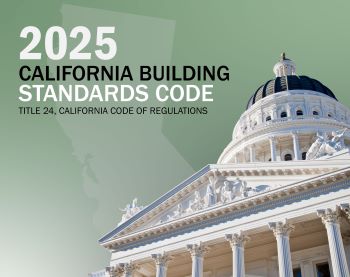CALCode Quarterly Summer 2025

 Stoyan Bumbalov
Stoyan Bumbalov
Summer salutations! I am pleased to welcome you to this issue of CALCode Quarterly. This edition will focus on the publication of the 2025 edition of the California Building Code, Title 24 of the California Code of Regulations, as well as activities we are undertaking for the beginning of the 2025 Intervening Code Adoption Cycle.
But first, let’s address the elephant in the room – AB 130 (Chapter 22, Statutes of 2025). We have received dozens of phone calls and emails asking what will happen now that AB 130 has chaptered. This enormous budget trailer bill includes language that affects building code adoption at the state and local level until 2031. At this time, the California Building Standards Commission (CBSC) is working with our legislative and legal teams to analyze and interpret the bill’s effect on our activities. When the analysis and interpretation are complete, CBSC will issue an information bulletin that will be sent to our subscribed interested parties using our mass email platform, and posted on our website on the News tab. If you are not signed up for our email list, please use the govDelivery link on our Contact webpage. You will submit your email address first, then select the “CBSC Communications” topic on the next page. Thank you for your patience and understanding as we work to provide you with accurate information.
Until we know for certain what will happen with upcoming code development over the next five to six years, CBSC is continuing with pre-cycle activities for the intervening cycle. Please read the featured article below to learn about our electric vehicle (EV), embodied carbon reduction, and plumbing code pre-cycle meetings, among other activities.
On an exciting note, we are celebrating the publication of the 2025 edition of Title 24. Our hard-copy binders arrived recently, and we think they look great on the shelf. We hope you find the new graphics pleasing, too. This new edition goes into effect on January 1, 2026. As I mentioned before, more information is forthcoming regarding local amendments.
To go along with the 2025 edition, CBSC has updated several of its existing publications, such as the Guide to Title 24, Code Book Fundamentals and It’s Your Building Department. These guides are vital for the proper use of Title 24 by designers, builders, and code enforcement officials. We are also pleased to announce the publication of the 2025 Summary of California Code Changes, which is a list of code amendments, adoptions and repeals made by state agencies during the last code adoption cycle. It is organized by the parts of Title 24, and then by chapter and state agency. With a knowledge of state agency authorities (explained in the Guide to Title 24), a code user can easily determine if changes have been made to regulations that affect their projects. I hope you find this resource helpful. All of these materials—and more—can be found on the CBSC website Resources tab, and there’s more information in the featured article below.
During the triennial cycle, some significant updates were made to EV charging requirements in the California Green Building Standards Code, Part 11 of Title 24, known as CALGreen. Our 2025 mascot, Codie the Bear, tells you all about these changes in the Codie’s Den feature of this newsletter.
CBSC has an outstanding staff, and every one of them is a valuable contributor to our overall mission and accomplishments. In this issue, we are spotlighting one of our leadership team members, Kevin Day. If I’m the captain of the CBSC ship, then Kevin is my first mate. This ship would absolutely flounder without him. So it is with great pleasure that we share some of our thoughts about and experiences with Kevin in the feature article below.
Finally, CBSC staff members have been out and about visiting our stakeholders and other interested parties at various events around the state. Take a look at our Education and Outreach sidebar to see where we’ve been and where we’re planning to be in the coming months.
That’s it for this newsletter. I hope you enjoy the remainder of your summertime.
Warmly,
Stoyan
Feature Articles Summer 2025
CBSC is pleased to announce the publication of the 2025 edition of the California Building Standards Code, Title 24 of the California Code of Regulations (Title 24) on July 1, 2025. This edition of Title 24 will go into effect on January 1, 2026, with the exception of certain chapters of the California Administrative Code (Part 1 of Title 24) that became effective 30 days after filing with the Secretary of State. Links to the published version of the 2025 code can be accessed on the Codes tab of CBSC’s website, where there are also links to the code publishers for those who want to purchase it.

In conjunction with the release of the 2025 edition of the code, the California Building Standards Commission (CBSC) will publish updated resources to help the public use and become familiar with Title 24:
2025 Summary of California Code Changes (new July 2025). One of our most popular new publications, this summary lists the changes made by state agencies to the previous edition of Title 24, including amendments to model codes as well as California-only codes. This summary is published as a webpage and in a downloadable PDF booklet.
Guide to Title 24 (revised July 2025). Updated every three years, this comprehensive guide covers the organization and construction of Title 24, how to use tools such as Matrix Adoption Tables, information specific to certain occupancies, and an overview of local adoption and amendment of building standards, among other topics. CBSC recommends that new and seasoned code users review this guide.
Guide for Local Amendments of Building Standards (2025 edition coming soon). A must-read for local jurisdiction building department personnel who plan to make amendments to Title 24 for enforcement in their county or city. This guide has been revised to reflect current processes for all amendments to Title 24, including which state agencies other than CBSC accept filings for amendments under their authority.
It’s Your Building Department (revised July 2025). Another valuable resource for local authorities having jurisdiction relative to the statutory requirements for building departments and enforcement of building standards.
Code Book Fundamentals (revised July 2025). Reading, applying and enforcing Title 24 regulations can be confusing and challenging. This guide is intended to help the code user become more familiar with Title 24, and other laws and regulations, and how to use them.
A Public Guide to the Building Standards Adoption Process (2025 edition coming soon). Designed for the general public, this guide provides an overview of how the codes in Title 24 are developed in a publicly inclusive and transparent process, including a description of the various state agencies and their authorities.
These publications are available on the Resources tab of CBSC’s website. As always, CBSC staff members are available to answer your questions and usually return calls and emails within one business day. Contact us at cbsc@dgs.ca.gov or 916-263-0916.
Before the ink dried and the new 2025 California Building Standards Code, Title 24 of the California Code of Regulations (Title 24), was published, the California Building Standards Commission (CBSC) had already started the 2025 Intervening Code Adoption Cycle. During this cycle, state agencies will propose amendments to the 2025 edition of Title 24. Submittals of proposed building standards are due to CBSC by December 1, 2025. Building standards approved and adopted during this cycle will be published on January 1, 2027, and go into effect on July 1, 2027.
The cycle kicked off on May 6, 2025, with a meeting of the Coordinating Council, made up of representatives from the state proposing and adopting agencies. At the meeting, a brief overview of the upcoming cycle was provided, including due dates and a summary of each agency’s planned proposals. One benefit of this meeting is that if two or more agencies are thinking of making similar changes, this meeting reveals that and allows them to begin coordination efforts.
After Coordinating Council, the agencies’ next steps are to hold workshops with interested parties and industry stakeholders to draft the proposed code amendments. CBSC has held three workshops so far to develop updated regulations for electric vehicle charging, embodied carbon reduction and plumbing fixture counts, with follow-up workshops planned to finalize proposed code amendments.
Other state agencies, such as the Department of Housing and Community Development (HCD) and the Division of the State Architect (DSA), may hold their own workshops and public comment periods regarding their proposals. To receive notice of in-person workshops as well as notices of comment periods, subscribe to the mailing lists for the agencies that develop the codes of interest. Appendix D of the Public Guide to the Building Standards Adoption Process is a list of the state agencies and a short description of their authority in Title 24. For more detailed information, refer to Chapter 1 of the California Building Code, Part 2 of Title 24. Note that CBSC does not always send out notices about other agencies’ workshops.
The purpose of workshops and public comment periods is to get input and feedback from as many interested people and industry representatives as possible. This public and transparent process is essential to crafting regulations that are fair and reasonable and allows state representatives to hear from experts in the field. Pre-cycle development of the codes is when the public can have the most impact because it is before proposed regulations go through a rigorous evaluation that reaches the highest levels of an agency as well as the state’s financial review process. Once the fiscal and economic impacts of a proposal have been analyzed and approved, the potential to make significant changes decreases due to the possibility of a change to those impacts. Because of the time constraints of a rulemaking cycle, there is usually no time to go through a second financial review.
Check back this autumn, when CALCode Quarterly will reveal more about the 2025 Intervening Code Adoption Cycle.
When you go to sea on a ship, you want to be assured you have a captain who has sailed those seas before, and when you get on an airplane, you want to feel certain the pilot has previously flown a plane. And when you are conducting the rulemaking process for the adoption and development of building standards in California, you want to know that your leader is knowledgeable, dedicated and thoughtful. Here at CBSC, we are lucky to have a Deputy Executive Director who is all that…and more!
Kevin Day is the kind of leader every team wishes it had. CALCode Quarterly asked some CBSC colleagues to share what they love about Kevin, and here’s what they said:
Executive Director Stoyan Bumbalov: “Kevin is like a walking AI, but better. You ask the AI, and you will get the answer right away. You ask Kevin, and you don’t only get the answer right away, but you also get the history and a funny story with it. This is why I ignore the AI and always go to Kevin.”
Associate Governmental Program Analyst (AGPA) Pamela Maeda (Executive Assistant): “Kevin has great attributes and positive qualities along with strong leadership, communication, and management skills. He is strong in building relationships, working collaboratively to meet deadlines, and fostering a positive work environment. When he comes in each day, he starts off running, working right away on managing multiple tasks, prioritizing effectively, and meeting deadlines for each day.”
Associate Architect Havel Weidner: “My favorite moments with Kevin come from his love of literature and film. For any movie I mention or major work of literature that comes up, Kevin has an anecdote about the history and significance of that work and recommends several other great things to watch or read. His impassioned description of the 1922 silent film Nosferatu—which thanks to Kevin I now know is a rebranded Dracula story which was trying to avoid copyright violation—led me to spend an evening watching the first silent film I have ever seen!”
AGPA Barbara Trusley (Personnel and Finance): “Kevin is the absolute best! Regardless of his demanding workload, Kevin is professional, approachable, positive, and has a great sense of humor. He conducts himself with poise and tact and has a wealth of knowledge to share. He’s a gem and we’re so fortunate to have him.”
Associate Construction Analyst Tom Martin: “I think that in a world where it is politically correct for bosses to say that they welcome all employees’ input always, Kevin not only says that, but he actually means it. He also truly wants (and helps) each and every employee to succeed in their job!”
AGPA Laura Mills (Education and Outreach): “Kevin and I have bonded over music – especially the band U2. We are actually now U2-tattoo siblings! Kevin’s encyclopedic mind is not limited to Title 24…he knows all sorts of details about all types of music and literature and movies…and he’s really fun to play trivia with. Kevin puts the FUN in CBSC.”
Staff Services Manager I (Specialist) Lara Paskins: “There’s so much I love about him…but the fact that he is a walking encyclopedia and seems to have a photographic memory when it comes to code sections and legislation are a couple of my favorite things!”
Associate Construction Analyst Beth Maynard: “I appreciate Kevin and his ability to lead by example. I have had the pleasure of working with Kevin for six years and have learned so much from him. He is beyond organized, he has his own unique style that exudes confidence and trust, and he makes it easy to come to work every day. He communicates expectations clearly and effectively which allows for me to work independently, and his Jib Jabs, trivia and Wordle are the icing on the cake at our staff meetings. I have never had a boss who I have enjoyed working for as much as him.”
Associate Construction Analyst Enrique M. Rodriquez: “One of my most memorable times with Kevin was about 13 years ago when Kevin, myself, and our executive and deputy directors at that time participated in a charity event called “Walk a Mile in Her Shoes” where men walk a mile in high heels to raise awareness about issues like sexual assault and domestic violence. We all wore high heels and Kevin wore red heels, white socks, tan shorts and a purple shirt. We were supposed to walk a mile, but some guys I don’t think even made it to a quarter mile before complaining about how it hurt. Kevin, was that you? Ha ha! The best memory ever with Kevin!”

Kevin and Enrique Walk a Mile (maybe? almost?)
Staff Services Manager I Cynthia Biedermann: “Talk about the right stuff! Kevin just has this energetic spark about him that is welcoming, fun, earnest, and very present. Yeah, I’d definitely want a savvy sea captain and a pilot with a lot of time in the air, but Kevin is the guy I’d want in my boat when push comes to shove. He is one of the hardest working people I’ve ever met. He leads by example, and he makes us all better because of it. He acknowledges and encourages his staff literally every working day. He’s a remarkable boss and natural leader. We are all lucky to work with him, and in my humble opinion, the State of California is equally as fortunate to have such a dedicated, wicked smart and capable, fair and honorable man representing it.”
As you can see, Kevin is a treasure both professionally and personally, and CBSC would not be the same without him.
Codie's Den

Grrrrr-eetings everyone! Codie the Bear here. I hope this summer is going well for all my human friends. I have been foraging and grubbing and enjoying my forest, and I want to thank all of you for caring and working hard to create a healthy and sustainable built environment here in California.
I know my friends at the California Building Standards Commission (CBSC) are beginning the process to develop or amend regulations in the California Green Building Standards Code, Part 11 of Title 24 (CALGreen) to further reduce greenhouse gas emissions and embodied carbon in the environment.
The 2025 edition of the California Building Standards Code, Title 24 of the California Code of Regulations (Title 24) was published on July 1, and the regulations will go into effect January 1, 2026. In the last edition of CALCode Quarterly, you learned about the mandatory embodied carbon reduction codes in CALGreen. For this edition, I want to share with you the updated electric vehicle charging requirements for non-residential occupancies under CBSC’s authority.
In the 2022 CALGreen code that is in effect until the end of December, there are requirements for electric vehicle (EV) charging based on the number of parking spots in a lot associated with a non-residential building, and there are two compliance pathways to meet the requirements – EV Capable Spaces and the Power Allocation Method. These two methods of complying with the regulations are intended to allow designers and builders flexibility when deciding how to provide EV charging for a building’s occupants.
During the Triennial Code Adoption Cycle that produced the 2025 edition of CALGreen, these regulations were updated to increase the mandatory number of EV charging spaces. The requirements have also been separated into “Other Than Office and Retail” and “Office and Retail” in recognition of the different dwell times for those categories of occupancies. All the options are demonstrated with handy tables in CALGreen.
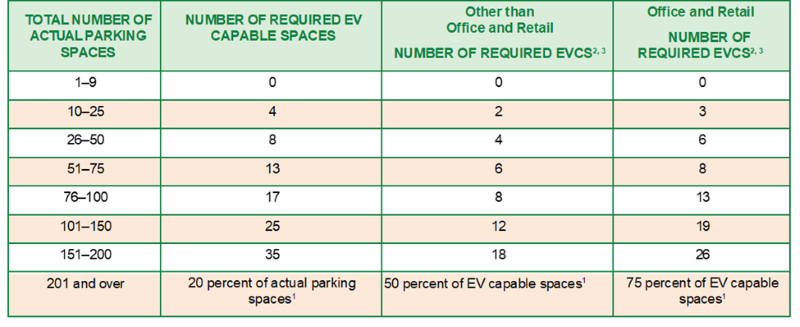
Here is an example of the increase for the EV Capable Spaces pathway for an “Other than office and retail” parking lot with between 101 and 150 spaces: 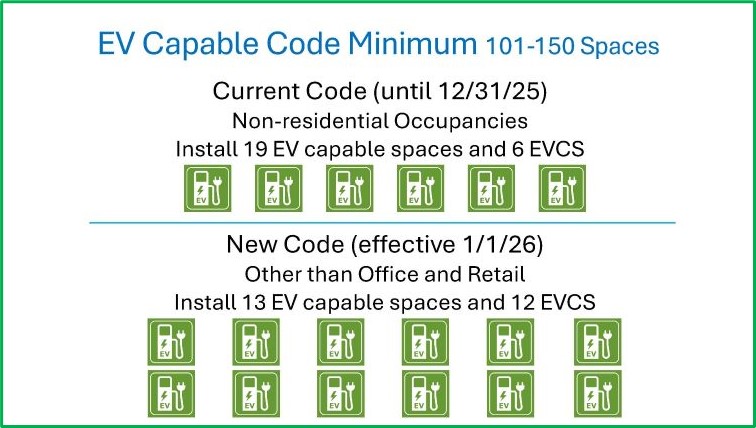
For detailed information about code changes in CALGreen, check out CBSC's 2025 Summary of California Code Changes (see link in the E&O sidebar), or watch for the 2025 CALGreen Guide, published by our partner—the International Code Council. The Guide provides code language, a brief explanation of the intent of the requirements, any changes for the new edition, compliance and enforcement suggestions and examples.
These requirements were developed with the participation of industry experts and interested parties, and CBSC’s efforts are continuing into the next code adoption cycle. Watch your email inbox for notices about upcoming workshops where the public can provide input for the future development of EV charging regulations.
In the next CALCode Quarterly, I’ll share more about the new, updated Guide to the California Green Building Standards Code - Nonresidential that is published for each new edition of CALGreen. Until then, enjoy your summer and I’ll see you in the Fall.
Codie the Bear

Website update - Letting you know what's going on
Education and Outreach
May 2025 was a busy month for the California Building Standards Commission (CBSC).
Every May, the International Code Council (ICC) promotes Building Safety Month with support and participation from national, state and local governments and their representatives who are involved in the building industry, and particularly code development and enforcement. CBSC participates on behalf of the state of California by working with the governor’s office to issue a signed declaration to raise awareness about building safety. This year, the theme of the campaign was “Game On” and encouraged the state’s residents to learn about and appreciate the roles of code developers and enforcers who work diligently to keep our buildings safe and resilient.
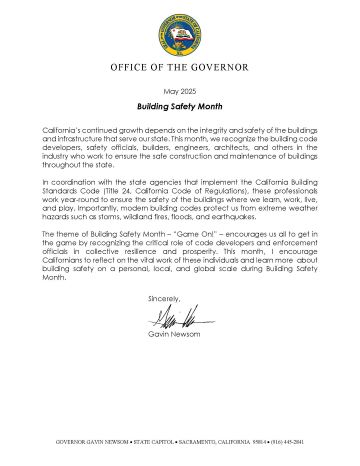
Another annual event that usually happens in May is the California Building Officials (CALBO) Leadership Academy luncheon. CBSC is honored to be invited to join this distinguished group of building officials as they celebrate their accomplishments. On May 9, Deputy Executive Director Kevin Day and Associate Construction Analyst Enrique Rodriguez addressed new and experienced building officials in Costa Mesa.

Enrique M. Rodriguez at the Sustainable Facilities Forum
On May 15 in Sacramento, Green Technology produced the 19th annual Sustainable Facilities Forum (SFF). This event brings together government and industry partners dedicated to protecting precious resources and the environment by constructing and operating buildings using sustainable materials, processes and equipment. Each year, CBSC presents a session about new non-residential building standards in the California Green Building Standards Code, Part 11 of Title 24 (CALGreen) and hosts a table where attendees can stop by to ask specific questions and learn more about CALGreen. This year, our table was hosted by Associate Construction Analyst Enrique M. Rodriguez, Education and Outreach Coordinator Laura Mills, Associate Architects Havel Weidner, Tim Freeman and Woo Cheong, Associate Construction Analyst Tom Martin, and Office Technician Marissa Magdaleno. Also in attendance were SFF Advisory Committee members Ida Clair, California State Architect, and Lindsey Rowell, Chief of the Energy, Sustainability and Transportation unit of the California State University Office of the Chancellor, who stopped by the CBSC tabletop for a visit with staff.
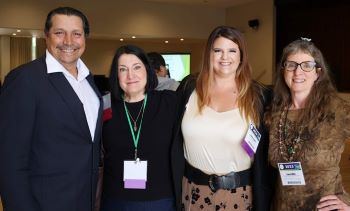
Enrique M. Rodriguez, Ida Clair, Lindsey Rowell, and Laura Mills
CBSC partners with ICC for more than just the model codes and publication of Title 24. Our staff members also visit ICC chapter meetings across the state in order to share updates about CBSC activities, including how members can participate in the development of California’s regulations. On May 16, Supervising Architect Irina Brauzman and Deputy Executive Director Kevin Day attended the ICC chapter meeting in Santa Cruz, and on June 4, Associate Construction Analyst Beth Maynard and Associate Architect Tim Freeman went to Fairfield to talk with the Napa-Solano chapter.
CBSC staff are happy to have these opportunities to meet with our industry partners. If you would like to invite CBSC to speak at a meeting or event, please email cbsctraining2@dgs.ca.gov.
Lastly, as mentioned in other articles in this newsletter, many of our publications have been updated to accompany the new edition of Title 24. Please visit our Resources page to view the 2025 Summary of California Code Changes, the Guide to Title 24, and more.
